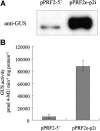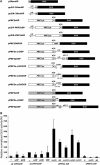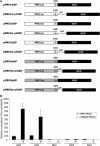Distinct roles of the first introns on the expression of Arabidopsis profilin gene family members
- PMID: 16361517
- PMCID: PMC1326044
- DOI: 10.1104/pp.105.071316
Distinct roles of the first introns on the expression of Arabidopsis profilin gene family members
Abstract
Profilin is a small actin-binding protein that regulates cellular dynamics of the actin cytoskeleton. In Arabidopsis (Arabidopsis thaliana), five profilins were identified. The vegetative class profilins, PRF1, PRF2, and PRF3, are expressed in vegetative organs. The reproductive class profilins, PRF4 and PRF5, are mainly expressed in pollen. In this study, we examined the role of the first intron in the expression of the Arabidopsis profilin gene family using transgenic plants and a transient expression system. In transgenic plants, we examined PRF2 and PRF5, which represent vegetative and reproductive profilins. The expression of the PRF2 promoter fused with the beta-glucuronidase (GUS) gene was observed in the vascular bundles, but transgenic plants carrying the PRF2 promoter-GUS with its first intron showed constitutive expression throughout the vegetative tissues. However, the first intron of PRF5 had little effect on the reporter gene expression pattern. Transgenic plants containing PRF5 promoter-GUS fusion with or without its first intron showed reproductive tissue-specific expression. To further investigate the different roles of the first two introns on gene expression, the first introns were exchanged between PRF2 and PRF5. The first intron of PRF5 had no apparent effect on the expression pattern of the PRF2 promoter. But, unlike the intron of PRF5, the first intron of PRF2 greatly affected the reproductive tissue-specific expression of the PRF5 promoter, confirming a different role for these introns. The results of a transient expression assay indicated that the first intron of PRF1 and PRF2 enhances gene expression, whereas PRF4 and PRF5 do not. These results suggest that the first introns of profilin genes are functionally distinctive and the first introns are required for the strong and constitutive gene expression of PRF1 and PRF2 in vegetative tissues.
Figures








Similar articles
-
An upstream region in the first intron of petunia actin-depolymerizing factor 1 affects tissue-specific expression in transgenic Arabidopsis (Arabidopsis thaliana).Plant J. 2007 Apr;50(2):230-9. doi: 10.1111/j.1365-313X.2007.03053.x. Epub 2007 Mar 21. Plant J. 2007. PMID: 17376165
-
Plant profilin isovariants are distinctly regulated in vegetative and reproductive tissues.Cell Motil Cytoskeleton. 2002 May;52(1):22-32. doi: 10.1002/cm.10029. Cell Motil Cytoskeleton. 2002. PMID: 11977080
-
Arabidopsis profilin isoforms, PRF1 and PRF2 show distinctive binding activities and subcellular distributions.J Integr Plant Biol. 2009 Feb;51(2):113-21. doi: 10.1111/j.1744-7909.2008.00781.x. J Integr Plant Biol. 2009. PMID: 19200149
-
[Profilins in plant cells].Zhi Wu Sheng Li Yu Fen Zi Sheng Wu Xue Xue Bao. 2006 Jun;32(3):261-70. Zhi Wu Sheng Li Yu Fen Zi Sheng Wu Xue Xue Bao. 2006. PMID: 16775392 Review. Chinese.
-
Aox gene structure, transcript variation and expression in plants.Physiol Plant. 2009 Dec;137(4):342-53. doi: 10.1111/j.1399-3054.2009.01284.x. Epub 2009 Aug 26. Physiol Plant. 2009. PMID: 19781002 Review.
Cited by
-
Upstream regulatory architecture of rice genes: summarizing the baseline towards genus-wide comparative analysis of regulatory networks and allele mining.Rice (N Y). 2015 Feb 28;8:14. doi: 10.1186/s12284-015-0041-x. eCollection 2015. Rice (N Y). 2015. PMID: 25844119 Free PMC article.
-
Genome-Wide Identification, Expression, and Protein Analysis of CKX and IPT Gene Families in Radish (Raphanus sativus L.) Reveal Their Involvement in Clubroot Resistance.Int J Mol Sci. 2024 Aug 17;25(16):8974. doi: 10.3390/ijms25168974. Int J Mol Sci. 2024. PMID: 39201660 Free PMC article.
-
Assembled and annotated 26.5 Gbp coast redwood genome: a resource for estimating evolutionary adaptive potential and investigating hexaploid origin.G3 (Bethesda). 2022 Jan 4;12(1):jkab380. doi: 10.1093/g3journal/jkab380. G3 (Bethesda). 2022. PMID: 35100403 Free PMC article.
-
Functional characterization of two p-coumaroyl ester 3'-hydroxylase genes from coffee tree: evidence of a candidate for chlorogenic acid biosynthesis.Plant Mol Biol. 2007 May;64(1-2):145-59. doi: 10.1007/s11103-007-9141-3. Epub 2007 Feb 27. Plant Mol Biol. 2007. PMID: 17333503
-
Sugar levels modulate sorbitol dehydrogenase expression in maize.Plant Mol Biol. 2008 Oct;68(3):203-13. doi: 10.1007/s11103-008-9362-0. Epub 2008 Jun 20. Plant Mol Biol. 2008. PMID: 18566893
References
-
- Arabidopsis Genome Initiative (2000) Analysis of the genome sequence of the flowering plant Arabidopsis thaliana. Nature 408: 796–815 - PubMed
-
- Balŭska F, Jásik J, Edelmann HG, Salajová T, Volkmann D (2001) Latrunculin B induced plant dwarfism: plant cell elongation is F-actin dependent. Dev Biol 231: 113–124 - PubMed
-
- Bamburg JR, McGough A, Ono S (1999) Putting a new twist on actin: ADF/cofilins modulate actin dynamics. Trends Cell Biol 9: 364–370 - PubMed
-
- Bolle C, Herrmann RG, Oelmuller R (1996) Intron sequences are involved in the plastid- and light-dependent expression of the spinach PsaD gene. Plant J 10: 919–924 - PubMed
Publication types
MeSH terms
Substances
LinkOut - more resources
Full Text Sources
Other Literature Sources
Molecular Biology Databases

